英语写作的主题句和段落
- 格式:ppt
- 大小:189.50 KB
- 文档页数:86
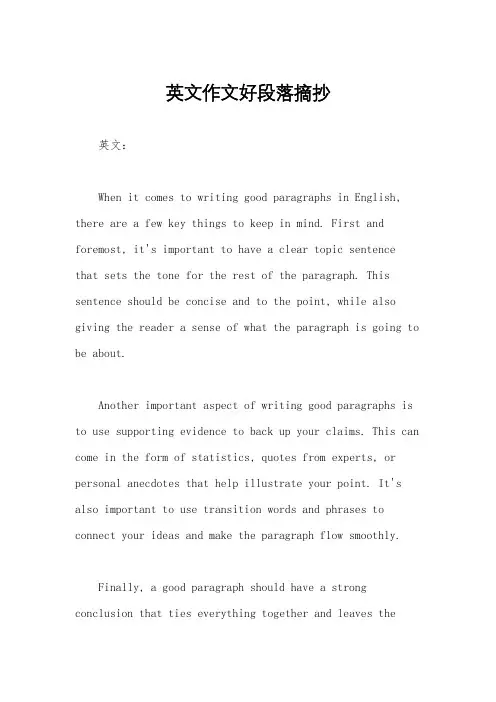
英文作文好段落摘抄英文:When it comes to writing good paragraphs in English, there are a few key things to keep in mind. First and foremost, it's important to have a clear topic sentencethat sets the tone for the rest of the paragraph. This sentence should be concise and to the point, while also giving the reader a sense of what the paragraph is going to be about.Another important aspect of writing good paragraphs is to use supporting evidence to back up your claims. This can come in the form of statistics, quotes from experts, or personal anecdotes that help illustrate your point. It's also important to use transition words and phrases to connect your ideas and make the paragraph flow smoothly.Finally, a good paragraph should have a strong conclusion that ties everything together and leaves thereader with a clear understanding of what you were tryingto say. This can be done by restating your main points or offering a final thought or recommendation.中文:要写好英文段落,有几个关键点需要注意。
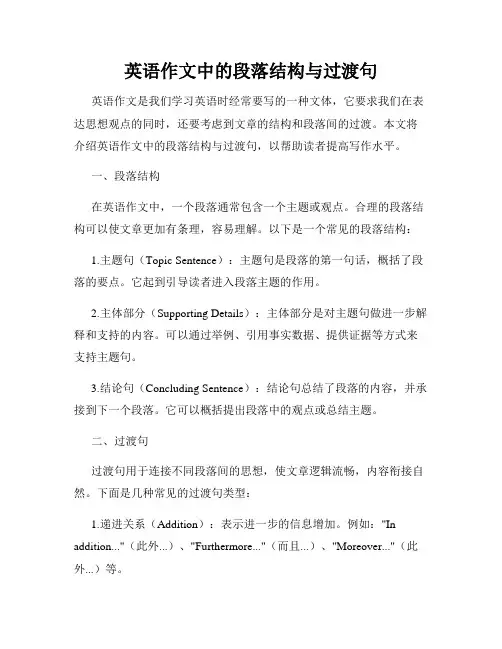
英语作文中的段落结构与过渡句英语作文是我们学习英语时经常要写的一种文体,它要求我们在表达思想观点的同时,还要考虑到文章的结构和段落间的过渡。
本文将介绍英语作文中的段落结构与过渡句,以帮助读者提高写作水平。
一、段落结构在英语作文中,一个段落通常包含一个主题或观点。
合理的段落结构可以使文章更加有条理,容易理解。
以下是一个常见的段落结构:1.主题句(Topic Sentence):主题句是段落的第一句话,概括了段落的要点。
它起到引导读者进入段落主题的作用。
2.主体部分(Supporting Details):主体部分是对主题句做进一步解释和支持的内容。
可以通过举例、引用事实数据、提供证据等方式来支持主题句。
3.结论句(Concluding Sentence):结论句总结了段落的内容,并承接到下一个段落。
它可以概括提出段落中的观点或总结主题。
二、过渡句过渡句用于连接不同段落间的思想,使文章逻辑流畅,内容衔接自然。
下面是几种常见的过渡句类型:1.递进关系(Addition):表示进一步的信息增加。
例如:"In addition..."(此外...)、"Furthermore..."(而且...)、"Moreover..."(此外...)等。
2.转折关系(Contrast):表示与前面的信息相反或相对立。
例如:"However..."(然而...)、"On the other hand..."(另一方面...)、"In contrast..."(相比之下...)等。
3.因果关系(Cause and Effect):表示原因和结果之间的关系。
例如:"As a result..."(结果是...)、"Therefore..."(因此...)、"Due to..."(由于...)等。
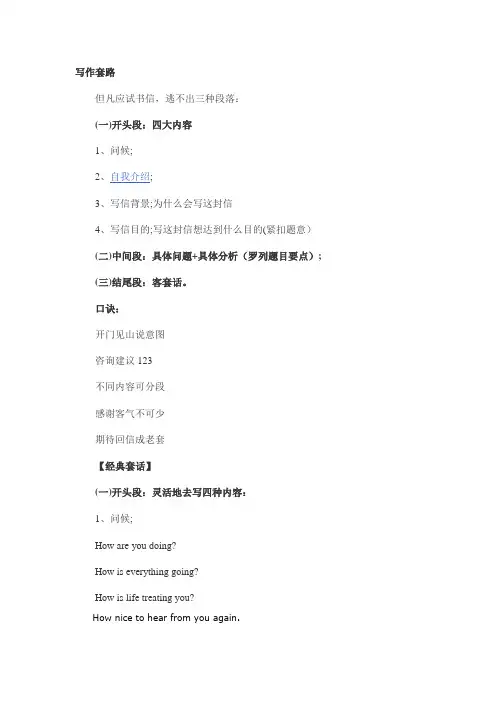
写作套路但凡应试书信,逃不出三种段落:(一)开头段:四大内容1、问候;2、自我介绍;3、写信背景;为什么会写这封信4、写信目的;写这封信想达到什么目的(紧扣题意)(二)中间段:具体问题+具体分析(罗列题目要点);(三)结尾段:客套话。
口诀:开门见山说意图咨询建议123不同内容可分段感谢客气不可少期待回信成老套【经典套话】(一)开头段:灵活地去写四种内容:1、问候;How are you doing?How is everything going?How is life treating you?How nice to hear from you again.很高兴再次收到你的回信Let me tell you something about the activity.让我告诉你一些关于这次活动的细节I’m glad to have received your letter of Apr. 9th.[/color]很高兴收到你在4月9号的来信I’m pleased to hear that you’re coming to China for a visit.很高兴得知你将来拜访中国I’m writing to thank you for your help during my stay in America.我正写这封信感谢我在美国你对我的帮助2、自我介绍;I am LiHua, a 17-year-old boy currently studying in XXX middle school.I am LiHua, who...【李华同志的个人简历】由于我们在考场上的身份几乎年年都是李华,因此我们在这里有必要了解一下李华同志的一些个人情况。
当然,这位同志的个人情况是可以有我们自己人为设置的。
为了给阅卷老师留下一个好印象,我们将李华同志的个人简历概括为:一个人见人爱的好孩子。
hardworkingdiligenthelp my parents to do houseworktake part in CCTV national English speech competitionwon the second prize in CCTV national English speech competitionvice monitorvice chairman of the students’ unionworked as a volunteer for the Olympic Gamesworked as a volunteer for the 21st centuryhave many foreign friends and often chat with them happily in starbark.3、写信背景(写信的缘由)I heard that ...My teacher told me...I am informed that...I learned that...我得知...I read in your newspaper/ micro-blog /website that...You said in your last letter that...4、写信目的;Now, I am writing to do sth.Now, I am writing this letter to do sth.Now, I am writing these few lines to do sth.【七种最常见书信的“写信目的”部分的最佳写法】自荐信:Now, I am writing to apply for the job/position.感谢信:Now, I am writing to show/ express my heartfelt gratitude to you.邀请信:Now, I am writing to invite you to join/enjoy/suffer/experience the....(as our guest/ judge/ instructor).建议信:Now, I am writing to give you a hand.求助信:Now, I am writing to ask you to give me a hand/ do me a favor.道歉信:Now, I am writing to show/ express my heartfelt apology to you.告知信:Now, I am writing to tell you about the details.(二)中间段:具体问题(主题句)+具体分析(拓展句)【六种最常见书信的“中间段”最佳写法】自荐信:写自己的优势写法一:There are four main reasons why I am fit for the position/job. To begin with, ... Moreover,... What's more,... Finally,...写法二:I have three main advantages. First and foremost,...Additonally,st but not least,...写法三:I have the confidence that I can handle the job. Firstly,... Secondly, ...Thirdly,...感谢信:写对方为你所做的事Every time I (看照片、看录像、看那段时间的日记、回忆那段经历), I just can't help thinking of you/ what you have done for me. It was so kind of you to (对方做的第一件事). Besides, you (对方做的第二件事), which really surprised me. Actually, I shall always remember (对方做的第三件事), considering that,(第三件事情的意义). Nothing will be able to erase our wonderful memories, and I will cherish them forever.邀请信:描述具体的活动内容,如活动主题、意义、地点、时间、参加者和其它事项;Here are some details for the activities. To begin with, (活动主题或活动目的,如:the theme of the contest is "human and the nature", which is undoubtedly not only entertaining but also instructive. )Moreover, (活动的地点和时间,如it will be in room 501 from 2:00 to 5:00 on the afternoon of June 15th.) What's more,(活动人员,如:ten outstanding competitors will take part in the contest.)Finally, (其他信息,如:if you need any further information, please call me at 44876655. )建议信:写给对方的具体建议写法一:There are several simple suggestions for you. To begin with, ... Moreover,... What's more,... Finally,...写法二:Immediate and effective measures must be put into practice. First and foremost,... Additonally,st but not least,...写法三:The following suggestions carried out, things would probably become much better. Firstly,... Secondly,... Thirdly,...求助信:写具体需要帮助的事项Hopefully you would be so kind as to give me some suggestions/help on the following problems. To begin with,(困难一),which has annoyed me for quite a long time. Moreover,(困难二), for personally I lack the very basic experience on this matter. Finally,...常用句型:(做某事有困难)1、I have trouble in doing sth.2、I find it extremely hard for me to do sth.3、Doing sth is another terrible headache for me.常见困难:【生活方面】与人相处get along well with my classmates/ the new teacher / my parents.(和我的同学/新老师/父母相处)把握时间arrange and make good use of my everyday time for valuable things. (安排和利用每天的时间去做有意义的事情)明确目标know the purpose of my life and the destination of my future in order to passionately live a purpose-driven life everyday. (知道我生命的目的和未来的目标,以便每天充满激情地过着“目标驱动”的生活)以下大家整理出来了高考英语作文中的万能句子。
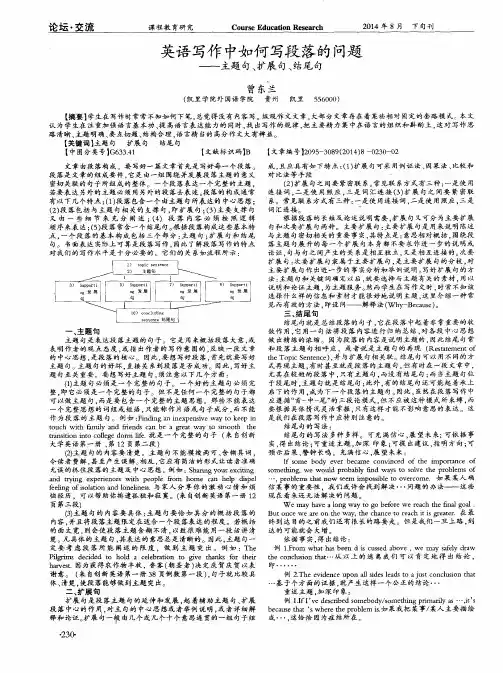
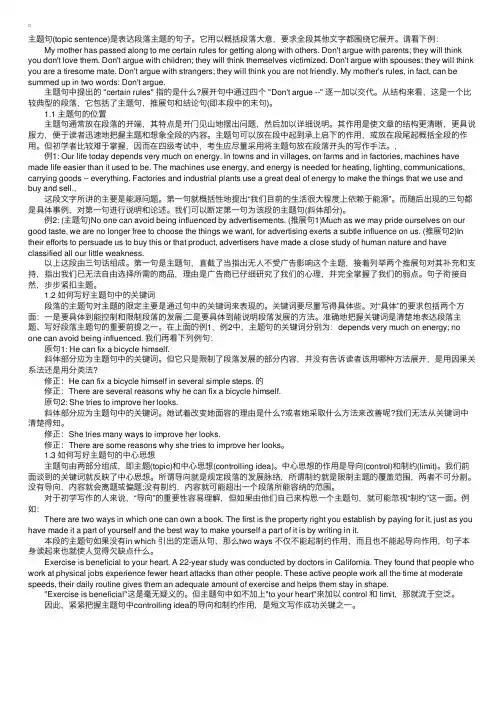
主题句(topic sentence)是表达段落主题的句⼦。
它⽤以概括段落⼤意,要求全段其他⽂字都围绕它展开。
请看下例: My mother has passed along to me certain rules for getting along with others. Don't argue with parents; they will think you don't love them. Don't argue with children; they will think themselves victimized. Don't argue with spouses; they will think you are a tiresome mate. Don't argue with strangers; they will think you are not friendly. My mother's rules, in fact, can be summed up in two words: Don't argue. 主题句中提出的 "certain rules" 指的是什么?展开句中通过四个 "Don't argue --" 逐⼀加以交代。
从结构来看,这是⼀个⽐较典型的段落,它包括了主题句,推展句和结论句(即本段中的末句)。
1.1 主题句的位置 主题句通常放在段落的开端,其特点是开门见⼭地摆出问题,然后加以详细说明。
其作⽤是使⽂章的结构更清晰,更具说服⼒,便于读者迅速地把握主题和想象全段的内容。
主题句可以放在段中起到承上启下的作⽤,或放在段尾起概括全段的作⽤。
但初学者⽐较难于掌握,因⽽在四级考试中,考⽣应尽量采⽤将主题句放在段落开头的写作⼿法。
, 例1: Our life today depends very much on energy. In towns and in villages, on farms and in factories, machines have made life easier than it used to be. The machines use energy, and energy is needed for heating, lighting, communications, carrying goods -- everything. Factories and industrial plants use a great deal of energy to make the things that we use and buy and sell., 这段⽂字所讲的主要是能源问题。
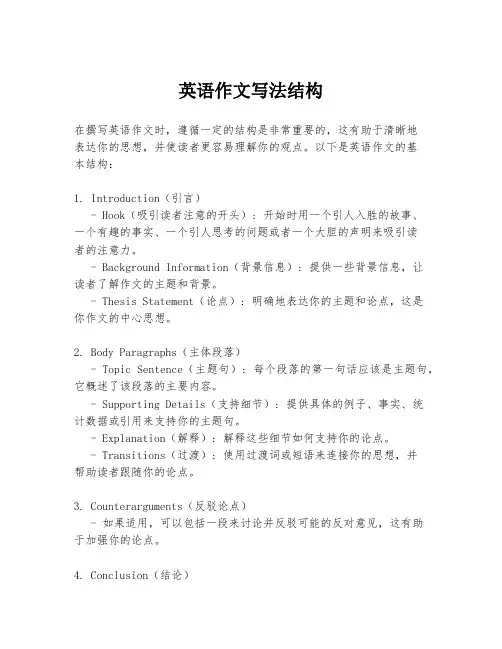
英语作文写法结构在撰写英语作文时,遵循一定的结构是非常重要的,这有助于清晰地表达你的思想,并使读者更容易理解你的观点。
以下是英语作文的基本结构:1. Introduction(引言)- Hook(吸引读者注意的开头): 开始时用一个引人入胜的故事、一个有趣的事实、一个引人思考的问题或者一个大胆的声明来吸引读者的注意力。
- Background Information(背景信息): 提供一些背景信息,让读者了解作文的主题和背景。
- Thesis Statement(论点): 明确地表达你的主题和论点,这是你作文的中心思想。
2. Body Paragraphs(主体段落)- Topic Sentence(主题句): 每个段落的第一句话应该是主题句,它概述了该段落的主要内容。
- Supporting Details(支持细节): 提供具体的例子、事实、统计数据或引用来支持你的主题句。
- Explanation(解释): 解释这些细节如何支持你的论点。
- Transitions(过渡): 使用过渡词或短语来连接你的思想,并帮助读者跟随你的论点。
3. Counterarguments(反驳论点)- 如果适用,可以包括一段来讨论并反驳可能的反对意见,这有助于加强你的论点。
4. Conclusion(结论)- Restate Thesis(重述论点): 重述你的论点,但不要直接复制引言中的句子。
- Summarize Main Points(总结要点): 简要回顾你的主要论点和支持细节。
- Closing Thought(结束语): 以一个强有力的结论来结束你的作文,这可以是一个引用、一个呼吁行动或一个令人难忘的声明。
5. Proofreading and Editing(校对和编辑)- 在完成初稿后,仔细校对和编辑你的作文,检查语法错误、拼写错误、标点符号以及逻辑上的不连贯之处。
记住,一篇好的英语作文不仅要有清晰的结构,还要有连贯的逻辑、准确的语言和有说服力的论据。

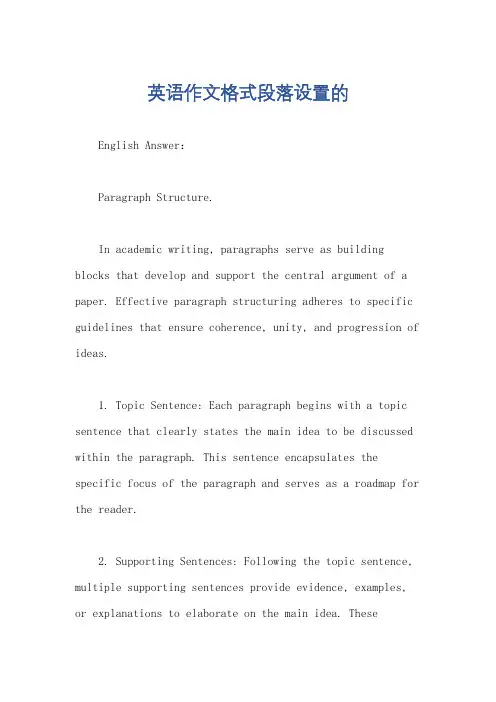
英语作文格式段落设置的English Answer:Paragraph Structure.In academic writing, paragraphs serve as building blocks that develop and support the central argument of a paper. Effective paragraph structuring adheres to specific guidelines that ensure coherence, unity, and progression of ideas.1. Topic Sentence: Each paragraph begins with a topic sentence that clearly states the main idea to be discussed within the paragraph. This sentence encapsulates the specific focus of the paragraph and serves as a roadmap for the reader.2. Supporting Sentences: Following the topic sentence, multiple supporting sentences provide evidence, examples, or explanations to elaborate on the main idea. Thesesentences should directly relate to the topic sentence and develop its content in a logical and organized manner.3. Transitions: Transitions connect paragraphs and ensure a smooth flow of ideas. They can be signal words (e.g., "moreover," "however," "in addition") or connecting phrases (e.g., "despite this fact," "as a result") that indicate the relationship between paragraphs.4. Concluding Sentence: Often, a concluding sentence provides a brief summary of the paragraph's main point and transitions to the next paragraph. It may reiterate the topic sentence or offer a concluding thought that ties together the ideas presented in the paragraph.Paragraph Length.Paragraph length varies depending on the complexity of the topic and the type of writing. However, academic writing typically avoids excessively short or long paragraphs. Ideally, paragraphs should be long enough to adequately develop the main idea without overwhelming thereader with too much information.Formatting.Paragraphs are separated by a single blank line in academic writing. They should be indented on the first line to visually distinguish them from the rest of the text.Additional Tips.Ensure unity by keeping all sentences within a paragraph focused on the same main idea.Avoid redundancy by not repeating the same information in multiple sentences.Use a variety of sentence structures and sentence lengths to enhance readability.Proofread carefully to ensure coherence and clarity throughout the paragraph.Chinese Answer:段落结构。
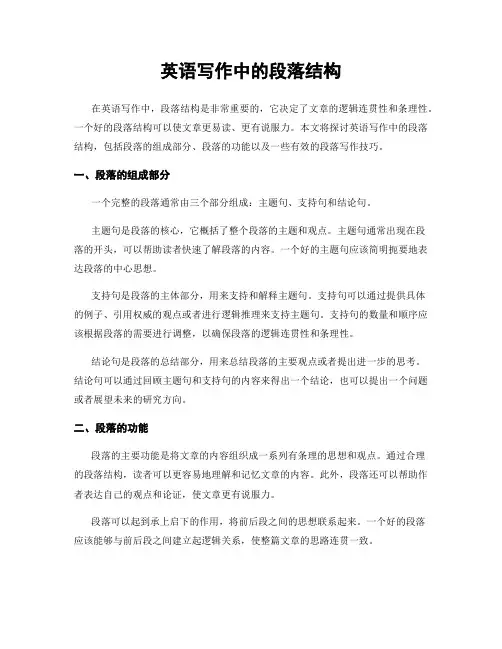
英语写作中的段落结构在英语写作中,段落结构是非常重要的,它决定了文章的逻辑连贯性和条理性。
一个好的段落结构可以使文章更易读、更有说服力。
本文将探讨英语写作中的段落结构,包括段落的组成部分、段落的功能以及一些有效的段落写作技巧。
一、段落的组成部分一个完整的段落通常由三个部分组成:主题句、支持句和结论句。
主题句是段落的核心,它概括了整个段落的主题和观点。
主题句通常出现在段落的开头,可以帮助读者快速了解段落的内容。
一个好的主题句应该简明扼要地表达段落的中心思想。
支持句是段落的主体部分,用来支持和解释主题句。
支持句可以通过提供具体的例子、引用权威的观点或者进行逻辑推理来支持主题句。
支持句的数量和顺序应该根据段落的需要进行调整,以确保段落的逻辑连贯性和条理性。
结论句是段落的总结部分,用来总结段落的主要观点或者提出进一步的思考。
结论句可以通过回顾主题句和支持句的内容来得出一个结论,也可以提出一个问题或者展望未来的研究方向。
二、段落的功能段落的主要功能是将文章的内容组织成一系列有条理的思想和观点。
通过合理的段落结构,读者可以更容易地理解和记忆文章的内容。
此外,段落还可以帮助作者表达自己的观点和论证,使文章更有说服力。
段落可以起到承上启下的作用,将前后段之间的思想联系起来。
一个好的段落应该能够与前后段之间建立起逻辑关系,使整篇文章的思路连贯一致。
段落还可以用来展开和发展一个主题或者观点。
通过提供具体的例子、引用权威的观点或者进行逻辑推理,段落可以帮助读者更深入地理解和思考一个主题或者观点。
三、段落写作技巧在写作段落时,有一些技巧可以帮助我们更好地组织和表达思想。
首先,要确保每个段落都有一个清晰的主题句。
主题句应该概括整个段落的中心思想,避免过于笼统或者模糊不清。
其次,要注意段落之间的过渡。
段落之间的过渡应该自然流畅,使读者能够顺利地跟随思路。
可以使用一些过渡词或者短语来引导读者,如"另一方面"、"相比之下"等。
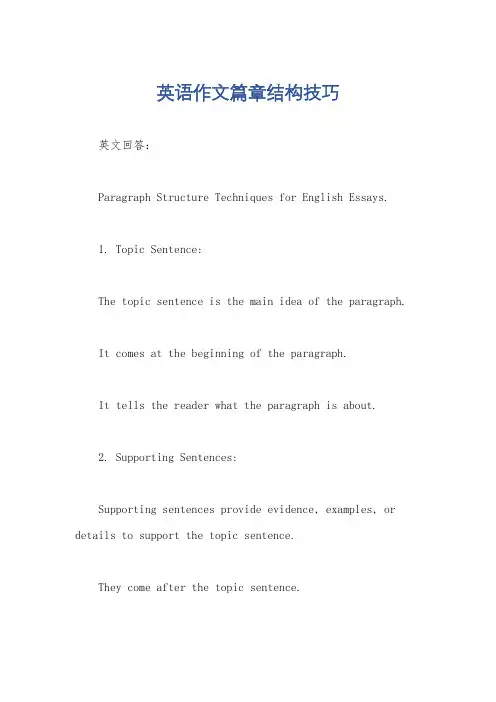
英语作文篇章结构技巧英文回答:Paragraph Structure Techniques for English Essays.1. Topic Sentence:The topic sentence is the main idea of the paragraph.It comes at the beginning of the paragraph.It tells the reader what the paragraph is about.2. Supporting Sentences:Supporting sentences provide evidence, examples, or details to support the topic sentence.They come after the topic sentence.They can be arranged in any order.3. Transitional Words:Transitional words connect the sentences in a paragraph and make the writing flow smoothly.They can be used to introduce examples, support claims, or show relationships between ideas.4. Concluding Sentence:The concluding sentence summarizes the main idea of the paragraph.It can also restate the topic sentence in a new way or provide a final thought.5. Paragraph Length:Paragraphs should be approximately 5-7 sentences long.Shorter paragraphs can be used for emphasis or to introduce a new idea.Longer paragraphs may be necessary to provide more in-depth information or analysis.6. Visual Appeal:Use white space and line breaks to create visual appeal and make the writing more readable.Use headings and subheadings to organize the text and make it easier to follow.7. Coherence and Cohesion:Coherence refers to the logical flow of ideas within a paragraph.Cohesion refers to the use of language and grammar to connect the sentences within a paragraph.中文回答:段落结构技巧。
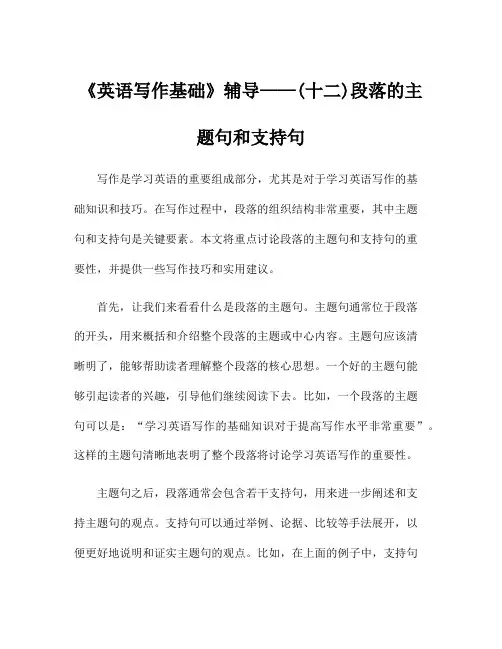
《英语写作基础》辅导——(十二)段落的主题句和支持句写作是学习英语的重要组成部分,尤其是对于学习英语写作的基础知识和技巧。
在写作过程中,段落的组织结构非常重要,其中主题句和支持句是关键要素。
本文将重点讨论段落的主题句和支持句的重要性,并提供一些写作技巧和实用建议。
首先,让我们来看看什么是段落的主题句。
主题句通常位于段落的开头,用来概括和介绍整个段落的主题或中心内容。
主题句应该清晰明了,能够帮助读者理解整个段落的核心思想。
一个好的主题句能够引起读者的兴趣,引导他们继续阅读下去。
比如,一个段落的主题句可以是:“学习英语写作的基础知识对于提高写作水平非常重要”。
这样的主题句清晰地表明了整个段落将讨论学习英语写作的重要性。
主题句之后,段落通常会包含若干支持句,用来进一步阐述和支持主题句的观点。
支持句可以通过举例、论据、比较等手法展开,以便更好地说明和证实主题句的观点。
比如,在上面的例子中,支持句可以是介绍学习英语写作基础知识的具体内容,比如语法、拼写、句型等方面的知识,以及如何运用这些知识来提高写作水平。
在对主题句和支持句的理解后,接下来我们将讨论如何构建一个有力的段落。
首先,写作时应该确立一个清晰的中心思想或观点,并将之概括成主题句。
然后,通过支持句来进一步阐述和支持这一观点。
在编写支持句时,可以运用一些写作技巧,如引用专家观点、举例论证、对比分析等方法,以加强段落的说服力和可信度。
此外,段落中的句子之间应该有适当的连接和过渡,以确保段落的结构紧凑和连贯。
另外,写作过程中还应该注重段落的长度和层次。
一个好的段落一般来说应该包含一个清晰的主题句和若干支持句,使得整个段落在几句话内能够概括清楚。
同时,段落之间的过渡也非常重要,可以通过使用连接词或过渡句来使得整篇文章条理清晰。
此外,段落的层次也应该互相协调,避免重复和冗余。
如果段落内容过于繁杂,可以考虑对其进行分割和重组,以确保各部分的内容清晰明了。
最后,写作是一个不断练习的过程,需要勤加练习和反思。
英语作文格式(精选多篇)一、英语作文的基本结构1. 引言(Introduction)引言是作文的第一部分,通常包括背景介绍、主题陈述和目的说明。
引言部分应简洁明了,吸引读者的注意力。
2. 主体(Body)主体部分是作文的核心,通常包括若干段落,每个段落围绕一个中心思想展开。
段落之间应有一定的过渡,使文章逻辑清晰。
3. 结论(Conclusion)二、英语作文的段落结构1. 主题句(Topic Sentence)2. 支持句(Supporting Sentences)支持句用于解释、举例或阐述主题句。
每个支持句应与主题句紧密相关,使段落内容充实、有说服力。
3. 过渡句(Transition Sentence)过渡句用于连接前后段落,使文章逻辑连贯。
过渡句可以是一个词、一个短语或一个完整的句子。
三、英语作文的写作技巧1. 使用丰富的词汇和句型在写作过程中,应尽量使用丰富的词汇和句型,避免重复。
同时,注意词汇的准确性和恰当性。
2. 注意语法和标点符号语法和标点符号是英语作文的基础,正确的使用可以提升文章的质量。
在写作过程中,应注意时态、语态、主谓一致等语法问题。
3. 适当运用修辞手法修辞手法可以使文章更具表现力,如比喻、拟人、排比等。
在运用修辞手法时,应注意适度,避免过度夸张。
4. 多次修改和润色完成初稿后,应多次修改和润色,检查文章的逻辑、语法、词汇等方面的问题。
在修改过程中,可以请教老师或同学的意见。
四、英语作文的格式要求1. 字体和字号通常情况下,英语作文应使用标准的字体,如Times New Roman或Arial,字号为12号。
这样可以保证文章的易读性。
2. 行距和段落间距为了提高文章的可读性,建议使用 1.5倍行距,段落之间空一行。
这样可以使文章看起来更加清晰、整洁。
3. 页边距页边距应设置为上下左右各2.54厘米,这样可以使文章在打印或提交时保持美观。
4. 页眉和页脚在页眉或页脚处,可以注明文章的题目、作者姓名、日期等信息。
英文作文主题摘抄格式英文:When it comes to choosing a topic for an English essay, there are a few things that I consider. Firstly, I think about my own interests and passions. Writing about something that I am genuinely interested in makes the process much more enjoyable and often leads to a better end result. Secondly, I consider the target audience. Who will be reading my essay? Is it for a teacher, a peer, or a wider audience? This can impact the tone and style of my writing. Finally, I think about the availability of resources and information on the topic. If there is little information available, it may be difficult to write a comprehensive essay.中文:当我选择英语作文的主题时,我会考虑几个方面。
首先,我会考虑自己的兴趣和热情。
写一些我真正感兴趣的东西会让整个过程更加愉悦,并且通常会得到更好的结果。
其次,我会考虑目标读者。
谁会读我的文章?是老师、同龄人还是更广泛的读者群体?这会影响我的写作风格和语气。
最后,我会考虑主题的信息和资源可获得性。
如果可获得的信息很少,可能很难写出全面的文章。
英语主题句在英语写作中,主题句是段落中的重要句子,用于表达段落的中心思想或主题。
以下是一些常见的英语主题句的例子:1. In my opinion, exercise is the key to a healthy life.(在我看来,锻炼是健康生活的关键。
)2. Technology has revolutionized the way we live and work.(技术已经彻底改变了我们生活和工作的方式。
)3. The importance of education cannot be overstated.(教育的重要性不可高估。
)4. Pollution is a great threat to the environment.(污染对环境构成了巨大威胁。
)5. Learning a second language is essential in today's globalized world.(在当今全球化的世界中,学习第二语言是必要的。
)6. The Internet has made it possible for people to connect regardless of distance.(互联网使人们无论距离远近都能相互连接。
)7. Travel broadens the mind and enriches our life experience.(旅行开阔眼界,丰富我们的生活经历。
)8. Being kind to others is one of the most important values we can possess.(善待他人是我们可以拥有的最重要的价值之一。
)9. The impact of climate change is an urgent global challenge that requires immediate action.(气候变化的影响是一个紧迫的全球性挑战,需要立即采取行动。
可供参考的常用主题句Time and place and number:1. Nowadays, supermarket (fast food / PDP TV / Internet surfing / imported goods / green food/ traveling / football / private cars / sports and games / scientists and inventors / cell phones/ cotton clothes / count ry music /…) is (are) gaining popularity in China.2.Nowadays, college students are facing three major challenges.3.In China, water shortages (population explosion / environmental pollution / traffic jam/high rate of crimes / high unemployment rate /…) are (is) a serious problem, especially inbig cities.4.Nowadays college graduates have many job options. (Computer / Internet / Private cars / Environmental pollution / Plastic electronics /Accession to WTO /…) affects our life in at least three ways.6. My automobile is one of the best vehicles in my neighborhood.7. There are quite a few unusual superstitions in China about marriage.Cause: 1. Alcoholic beverages should be banned from college campuses for two reasons.2. We do not trust hospitals as we did before for obvious reasons.3. There are many reasons in favor of owning a private car. (However, there are more reasonsagainst it.)4.Part-time job (Internet / Going abroad to study / Joint ventures and private companies /Government jobs / The reconstruc tion of the West in China /…) attract (s) college studentsfor two reasons.5.Several factors explain (account for / are responsible for / affect / have major impact on/…) water shortages (environmental pollution / population explosion / desertification /widespread corruption / the great economic success / the increasing popularity of mobilephones / the destruction of virgin forests / high rate of employment / the rapid growth ofscience and technology /…) in China.6.Part-time jobs attract college students for three main reasons.7.People oppose firecrackers (drug abuse / imported goods / corruption / private car / fakeproduct / tobacco industry / nuclear power station/ personal cult /…) for three majorreasons.Effect: Excessive drinking (Smoking / Drug abuse / Living in polluted areas / Exposure to radioactive irradiation / …) causes health problems.Similarity and Difference:1. There are a great deal similarities and differences between (English and Chinese / the cityand country lives / man and anim als / men and women/…).6.People have different attitudes towards private cars (China access to WTO / thebrain-drain problem in China ? trade protection / e-business / popularization of MandarinChinese /…)Others:1.Money is a good servant but a bad master.2.Good conversation opens the door to friendship.3.Without Internet it is difficult to imagine modern life.4.United we stand, divided we fall.5.The disaster (scandal / robbery / kidnap / smuggling case /…) exposed only the tip of anugly iceberg of organized crime.6.Fake product (Drug abuse / Terrorism / Corruption / Violence /…) is dangerous to oursociety.7.Man is guilty of wildlife extinction (environmental pollution / depletion of naturalresources / green-house effect / destruction of virgin forests / world-wide desertification/…).8.One can never exaggerate the deceptive nature of superstition (the importance ofinnovation / the significance of genetics advances / disastrous nature of corruption /…)9.To lend or not to lend money to a friend depends on specific situations.10.Science and technology (The wise policy of opening up and reform / Internet / Computers/ the innovation program ? Private enterprises / Information industry / High-techindustries /…)energize(s) our economy.11.A successful interview depends on three factors: job requirements, the qualification andmanners of the applicant.12.When it comes to recycling in China, there is still much room for improvement.13.There are at least three ways to fight crime (to save water / to stop desertification / to getpopulation under control / to reduce energy consumption / to eliminate fake products /…).14.Corruption is invading every pore of our society.15.There are many things we can do to save water (to fight against crimes / to live inharmony with wildlife / to wipe out corruption / to help the handicapped /…)/16.Honesty (Thrift / Self-dependence / Saving food / Industry / Modesty / Loving and caringfor the young and the old /…) is a good virtue.17.Job hunting by students (Internet / Tuition increase / The market economy / Part-time job/..) is having a big impact on campuses.18.In the race for quality (knowledge / happiness / understanding nature / democracy / betterlife / …), there is no finish line.19.Internet (Microelectronics / Computer / Private car / Electricity /…) revolutionizes ourlife.20.Briefly, here is how a mobile phone (a computer / a printer / tape recorder /…) works.21.It is not in the spirit of reverence for the children that education is conducted.22.Food is the source of energy for the body.23.Salt is the most useful and most amazing minerals on earth.24.Good manner is knowing the right things to do and say at the right times.25.Social skills (Good habits / Good manners / Environmental awareness / Sense ofresponsibility / Friendship / Mastery of English ?…) need(s) constant development.26.Mastery of English vocabulary (Eradication of superstition / Fighting corruption / Wipingout fake products / Wildlife preservation / Giving up smoking /…) is no picnic.27.As we proceed through life, we are faced with a variety of challenges and opportunities.28.Our problematic fire fighting (education / legal telecom / garbage recycling / water control/ disaster prevention/…) system is open to criticism.29.Water (Air / Oxygen / Food / Salt / Vitamin /…) is indispensable to life.30.Learning English affords a person many benefits.31.Causal reasoning may go from cause to effect or from effect to cause.32.Art can reflect a culture’s religious beliefs.33.Wise use of natural resources is an urgent concern of all countries.34.The most serious problem in Chi na’s economy is the growing number of state enterprisesthat suffer operational losses.35.Living in a place where the weather is always warm has its advantages.36.Natural resources are precious and limited.37. The problem of food supply can be solved by technological means.FORM FOR SELF-EV ALUATION:FOUR BASES FOR REVISING PARAGRAPHS / ESSAYS Title of your paper : ________________________________________________________________ Your name: ______________________________________________________________________ Base 1: Unity• Is there a clear opening statement of the point of the paper?• Does all the material in the paper support the opening point?Your comments:Score (up to 1 point): ________ Base 2: Support• Is there specific evidence?• Is there plenty of it?Your comments:Score (up to 1 point): ________ Base 3: Coherence• Is there a clear method of organization? (List of items or time order?)• Are transitions used to connect sentences and ideas?Your comments:Score (up to 1 point): ________ Base 4: Sentence Skills• Are there any rough spots where the sentences do not flow smoothly and clearly?• Have you checked carefully for mistakes in sp elling, grammar, punctuation, or usage? Your comments:Score (up to 1 point): ________TOTAL SCORE (up to 4 points): ________ Less than 2 points = rewrite2 - 2.7 = C2.8 -3.4 = B3.5 - 4 = A。
英语作文万能句型的应用与实践English essay writing often requires a blend of creativity, structure, and the ability to convey ideas clearly. Among the many tools available to writers, a set of universal sentence patterns stands out as a particularly useful asset. These patterns, when used effectively, can enhance the clarity, coherence, and impact of an essay. In this article, we will explore five such universal sentence patterns and how they can be applied to writing a high-quality English essay.The first sentence pattern is the topic sentence, which introduces the main idea of a paragraph. For instance, "The importance of education in modern society cannot be overstated." This sentence clearly states the central theme of the paragraph and sets the tone for the discussion that follows.The second pattern is the example sentence, which illustrates a point with specific evidence. For example, "One of the most significant benefits of education is its ability to expand one's horizons and increase cultural understanding. This is evident in the diverse perspectivesand open-mindedness of well-educated individuals." This sentence backs up the central theme with a specific example, adding depth and credibility to the argument.The third pattern is the cause-and-effect sentence, which explains the relationship between two events or ideas. For instance, "The rise in technology has had a profound impact on the way we live. It has not only made our lives more convenient but also created new challenges and opportunities." This sentence analyzes the consequences ofa particular development, providing a balanced view of its impact.The fourth pattern is the comparison-and-contrast sentence, which highlights the similarities and differences between two or more things. For example, "Although both movies and books are forms of entertainment, they differ significantly in their storytelling techniques. Moviesoften rely on visual effects and sound design, while books rely more on the reader's imagination." This sentence compares two media, outlining their unique strengths and weaknesses.Finally, the conclusion sentence sums up the main points of the essay and leaves a lasting impression on the reader. For instance, "In conclusion, the value of education cannot be overstated. It is not just about acquiring knowledge but also about developing critical thinking skills and becoming a contributing member of society." This sentence ties together the ideas presented throughout the essay and leaves the reader with a clear understanding of the writer's position.By mastering these five sentence patterns, writers can craft coherent and engaging essays that effectively communicate their ideas. However, it is important to note that while these patterns provide a solid foundation, they should not be relied upon exclusively. Good writing often involves a blend of creativity and innovation, as well as a tailored approach that suits the specific needs and context of the essay.**英语作文万能句型的应用与实践**英语作文写作往往需要融合创造力、结构和清晰表达思想的能力。
英语作文万能模板英语## 英文回答:Introduction。
Writing effective essays is a crucial skill in academic and professional settings. Employing a versatile essay template can streamline the writing process, ensure coherence, and enhance the overall quality of your writing. This comprehensive guide provides a detailed English essay template that can be adapted to various topics and writing styles.Body Paragraph Structure。
1. Topic Sentence: Begin each body paragraph with a topic sentence that clearly states the main point or argument you will discuss in that paragraph.2. Supporting Evidence: Provide specific examples,quotes, or data that support the topic sentence and develop your argument. Ensure the evidence is relevant, credible, and sufficient.3. Explanation and Analysis: Elaborate on the supporting evidence by explaining its significance, analyzing its implications, or drawing connections to your thesis statement.4. Transition Sentence: Conclude the body paragraph with a transition sentence that smoothly connects to the next paragraph or wraps up the discussion.Conclusion。